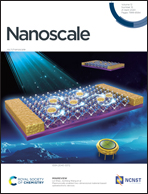Ambipolar transport in narrow bandgap semiconductor InSb nanowires†
Abstract
We report on a transport measurement study of top-gated field effect transistors made out of InSb nanowires grown by chemical vapor deposition. The transistors exhibit ambipolar transport characteristics revealed by three distinguished gate-voltage regions: In the middle region where the Fermi level resides within the bandgap, the electrical resistance shows an exponential dependence on temperature and gate voltage. With either more positive or negative gate voltages, the devices enter the electron and hole transport regimes, revealed by the resistance decreasing linearly with decreasing temperature. From the transport measurement data of a 1 μm-long device made from a nanowire of 50 nm in diameter, we extracted a bandgap energy of 190–220 meV. The off-state current of this device is found to be suppressed within the measurement noise at a temperature of T = 4 K. A shorter, 260 nm-long device is found to exhibit a finite off-state current and a circumference-normalized on-state hole current of 11 μA μm−1 at VD = 50 mV which is the highest for such a device to our knowledge. The ambipolar transport characteristics make the InSb nanowires attractive for CMOS electronics, hybrid electron–hole quantum systems and hole based spin qubits.



 Please wait while we load your content...
Please wait while we load your content...